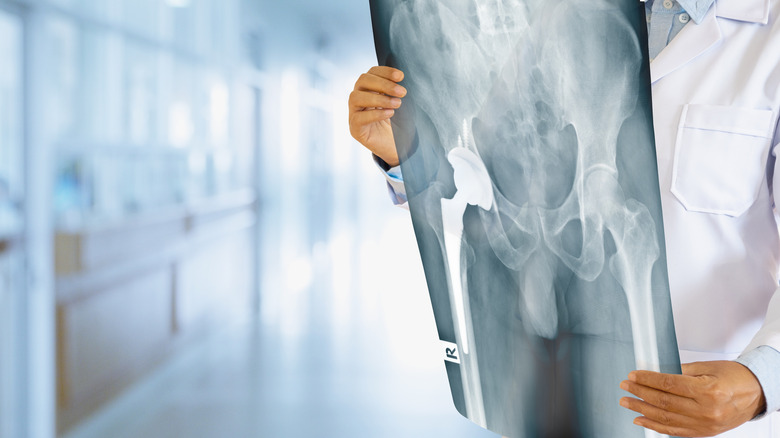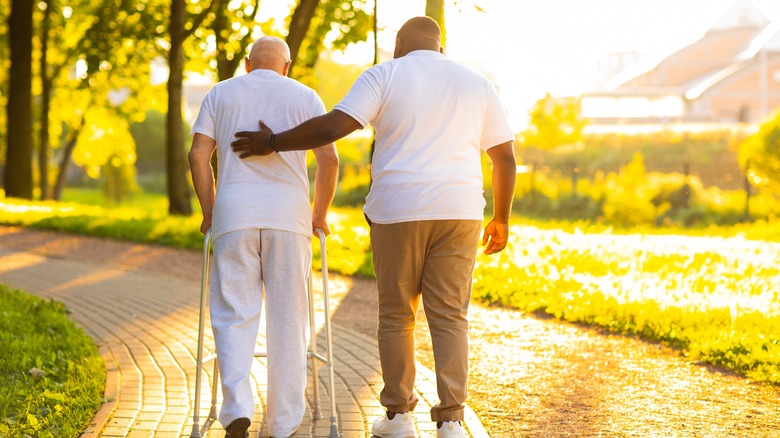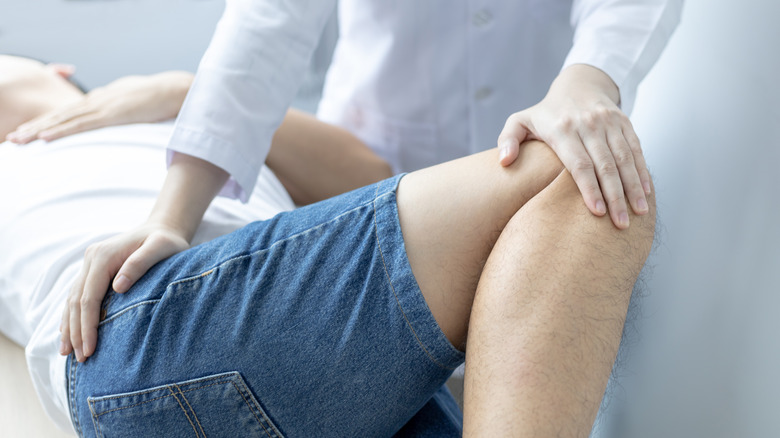Things You Should Never Do After Having Your Hip Replaced
Modern medicine sure is amazing, huh? While the thought of replacing a joint might have been unfathomable merely a few generations ago, nowadays it's more common than ever. And a hip replacement surgery is one of the more frequent procedures out there, with almost half a million of these operations performed each year in America, according to the American College of Rheumatology. A hip replacement surgery is pretty much what it sounds like: The surgeon operates to take out parts of your hip joint that have become damaged or worn down, and inserts artificial sections in their place, as WebMD states. This can lead to renewed function and a brand new lease on life.
But just because something is common doesn't mean it's simple. Hip replacements are complex procedures, and it's vital that during your post-operative period, you're giving your body the best chance of recovery. And when it comes to hip replacement surgery, you might do certain things without even thinking about them that could extend how long it takes until you're fighting fit again. That's why we decided to lay out all the things you should never do after a hip replacement.
You shouldn't bend over too far
It's frequent to have hip replacement surgery because of a decreased range of motion, often accompanied by pain (per WebMD). But post-surgery, you might find that your range of motion is also limited and that certain movements should be avoided. One of these is a simple act of bending over the hip, as Ortho Bethesda states. Bending over too far — more than a 60-degree angle — is not advised for several weeks after your surgery. This is especially the case with a posterior hip replacement (per Alberta Health Services).
This means that activities that you may have been previously doing every day may now be temporarily off the table. Bending over to tie your shoes, touching your toes, or even simply picking things up off the floor should be avoided for up to three months, so in preparation for your recovery, it might be worth grabbing some shoes that you can slip on, and asking a friend or family member to help you out when you encounter an activity that needs that type of movement. If you've had an anterior hip replacement, though, the good news is that you may not have to avoid bending in that fashion, mainly because the style of surgery doesn't destabilize the hip joint and its surrounding muscles in the same manner, meaning that dislocation from bending over is way less likely (per Arthritis-Health).
You shouldn't go swimming
Swimming is one of life's great pleasures, and as a low-impact workout that's kind to your joints, it might seem like it's the perfect mode of exercise to get you back to full health after hip replacement surgery (per JumpStart by WebMD). We highly advise, however, that you stay out of the pool until you're fully recovered. This is not just because you may risk compromising your new hip joint's stability and ability to heal. Swimming, and even sitting in a bath, can pose a risk to surgical wounds, as Johns Hopkins Medicine states. Although "the incisions for a hip replacement surgery nowadays are very small and are closed up with absorbable sutures," states total joint replacement expert and orthopedic surgeon Savya Thakkar, there's still a risk that excessive amounts of water could compromise them and lead to infection.
Instead, you should wait a minimum of six weeks post-surgery before you dip your toes back into the water or run a bath. Immediately after surgery, strip washing may be recommended by your doctor to reduce the risk of the wound getting wet (per The Royal Orthopedic Hospital). Using certain implements to help you get to hard-to-reach areas, like a long-handle sponge, may also be useful.
Don't assume the stairs will be the same
With the majority of your regular activities being in reach again roughly 12 weeks after a hip replacement, it won't be too long until you're almost back to your former life (per Spire Healthcare). But one thing that might take a little time to get to grips with is climbing stairs.
Going up and down staircases will be challenging for a period after surgery, and sloped walkways may also be difficult, as Tri County Orthopedics states. It's important to adapt your technique to make ascending and descending staircases as stress-free as possible. When you're walking upstairs, you should lead with the leg that hasn't had the operation, using it to pull your operated-upon hip up to join you. Ensure that you hold onto the handrail throughout to stabilize your body. When you're going downstairs, however, the opposite rule applies: You should place the leg that's had the operation down first, using your stronger leg to hold your body weight, and then shift the other leg down after it. As you might imagine, walking up and down stairs after hip surgery can take a little more time, but it's important to go slow to avoid any unfortunate accidents.
Attempt to take it easy on smoking
Smoking has a huge impact on health, and one of the areas that it can cause your body the most trouble is its ability to heal (per Carrothers Orthopedics). The substances that populate cigarette smoke can inhibit wound healing, with the carbon monoxide you inhale reducing the amount of oxygen your cells get, and the all-important nicotine constricting blood vessels and stopping blood from reaching the wound that needs to rebuild itself.
All of this, as you might imagine, can get in the way of your post-surgery care and ability to heal quickly and effectively. This can also raise your risk of infection after a hip replacement, as research published in The Journal of Bone and Joint Surgery shows. Researchers examined the rate of reoperation following joint surgery, comparing current smokers and non-smokers, and found that when people smoked, they were significantly more likely to need another surgical procedure thanks to an infection. If you do smoke, it's wise to speak to your doctor or surgeon about the risks surrounding surgery, and how they might be able to help you reduce smoking before and after surgery.
You shouldn't cross your legs
The act of crossing one's legs is a pretty unconscious move, not one that most people give a great deal of thought to. But if you're recovering from posterior hip replacement surgery, we'd recommend that you try and refrain from doing so until you're out of the woods recovery-wise.
It's advisable to hold off from crossing your legs for as long as eight weeks after your operation, according to Movement Orthopedics. While this may be easy in your waking hours, it can be a little harder to do while you're asleep. Some people may find it useful to sleep with something propped between their legs, like a pillow, or else to try as much as possible to sleep on their backs to prevent any unwanted cross-age. If you've had anterior hip replacement surgery, however, you may have slightly more freedom of movement. While posterior hip replacements sever ligaments that make crossing the legs a risky move, "With the anterior approach, none of these typical ligaments are cut, which means all of these common activities are safe immediately after surgery," states Fort Sanders Regional Medical Center orthopedic surgeon Paul Yau via Tennessee Orthopaedic Clinics.
You shouldn't play intense sports
Okay, so we're gonna go out on a limb here and assume that you're most likely not going to want to attend a HIIT class the day after your hip replacement. It is important to remember, however, that you might want to keep away from more intense sporting activities for longer than you think. It's recommended you wait a minimum of six weeks following your surgery before you try anything particularly strenuous sports-wise, Johns Hopkins Medicine states. This could be even longer depending on the nature of your hip replacement and the advice of your doctor.
If you're itching to get back out there, there are some activities you might be able to partake in. Sports like golf are usually accessible fairly quickly, thanks to their less-intensive nature. Simple exercises like walking can also be a great way to get active again, and can also assist in speeding up your recovery, as OrthoInfo says. It's important, though, not to overexert yourself too quickly. Ensure that you're using a walker if you normally use one or have been given one during your recovery, and only start with short distances, potentially with someone else who can help if you get into any trouble.
Don't try to rush things
Look, we get it. Waiting to recover can be really, really boring. And if you're anything like us, you'll likely want to get back out into the world and start living your life again as soon as possible. While we can understand this feeling, doing so before you're ready can create some serious issues, and if you try to run before you can walk (quite literally), you may end up becoming injured and prolonging your recovery (per Bella Vista Health).
Instead, take things slow. Remember that recovering from surgery can take longer than you anticipate, and that you may need to make adjustments to your lifestyle around your healthcare needs. It may also be worth discussing with your doctor if you should secure extra help while you're recovering, particularly if you live alone. Your doctor may recommend that you recover in place in a dedicated healthcare facility, or help you to organize a nurse or home health aide to visit you daily and assist with any specific needs you might have.
You shouldn't go back to work straight away
For some people, the thought of getting some time off work after a medical procedure, and spending endless hours doing not very much at all, fills them with joy. For others, that much free time can strike fear into the heart. Whichever camp you fall into, it's recommended that you give yourself at least a little time following a hip replacement before you go back to work, as the Royal College of Surgeons of England discusses. If you have a job that doesn't require too much physical activity and mainly involves sitting at a desk, you should aim to give yourself roughly six weeks before you head back to work. If your job requires you to be more physically active, you may need to give yourself a little more time.
What's important, though, is to not overdo it on the time off. Taking the rest you need during those crucial first few weeks will help you return to your regular activities as soon as you're able to, which will keep your spirits up and stop you from feeling cut off from the outside world.
Don't forget about onward care
Recovering from surgery can be a marathon, not a sprint. But sometimes, when we start to feel better after an operation, we can assume that all of those things that the doctor told us to do don't need to be done anymore. Well, not with a hip replacement. Continuing to stick to your prescribed onward care is paramount to the success of your recovery, and stops issues from developing while you're getting better, as Arthritis-Health says.
As such, if your surgeon or physical therapist has given you specific exercises, you should continue to perform them at the frequency they recommend. These exercises are usually intended to rehabilitate and build up the muscles around your hip, to support your brand-new joint. You should also tend to your surgical wounds, changing your dressing frequently and keeping the area clean, to limit the chance of infection. Make sure, too, that you continue to communicate with your doctor and surgeon during your recovery, and continue seeing them long-term. Regular check-ups on your hip joint can help your doctor assess how well it's faring post-surgery, and can prolong the life of your new joint.
You shouldn't skip your rehab
Rehab is an integral part of recovering from a hip replacement, states orthopedic surgeon and hip replacement specialist Andrew B. Richardson on his website. While your surgery may replace your hip, the physical therapy you do will help it heal correctly and aid in building your body back to full strength. Physical therapy is also important to keep your joints and muscles flexible, and boosts blood flow throughout your body, meaning that your wounds will close faster.
You'll likely begin physical therapy straight away after your surgery, to begin your recovery and hasten healing. Your physical therapist will demonstrate exercises that are designed to encourage circulation and a better range of movement, which you should be able to do with the compromised motion that you'll probably have after the procedure. While it's easy enough to do these under the supervision of a physical therapist, it's super important to continue them when you get home. By continuing to move, strengthen, and stretch your muscles, you'll make your recovery both easier and faster, and get back to living your life in earnest in no time.
Try not to sleep on your stomach
Sleeping stomach-side down isn't the most popular snoozing position in the world — in fact, only 16% of people sleep on their stomachs, according to a survey conducted by Anna's Linens, per PR Newswire. But if you are one of those people who just can't get enough of some belly-sleeping action, we'd advise you to rethink your positioning during your recovery from hip surgery. Sleeping on your stomach can create pressure on your hip joint and put it in a twisting position, which may dislocate your hip and create further problems (via Movement Ortho).
It's also recommended that you don't sleep on the side that you've had the operation on, as this can also risk prolonging your recovery. Instead, you should aim to sleep on your back while you're recovering from surgery, with a pillow placed between your legs for alignment and to prevent any leg crossing, as Ortho Bethesda recommends. If you're opting to sleep on your side, it's also wise to place a pillow between your legs to reduce the chance of your legs crossing. Make sure that you take your time getting in and out of bed, too, gently easing yourself in one leg at a time, leading with the leg that's had the hip replacement.
You should never sit down on anything too low
Got a particularly low chair in your home? Maybe an antique ottoman that's way comfier than it looks? No matter how tempted you are to park your butt on it, we'd recommend avoiding sitting in any especially low seats during your recovery, as doing so may inhibit the post-operative process (per the NHS). It's also recommended that you avoid using any particularly low toilet seats, and ask your doctor about alternatives and whether a raised toilet seat is an option.
It's also worthwhile to consider how you go about sitting down post-surgery more generally. Begin by standing in front of your chosen chair (which should have armrests), and back up gently until the backs of your legs are in contact with it, says the Cleveland Clinic. Hold onto the armrests from behind and use your arms to lower yourself down into the chair, pushing yourself back into it, avoiding folding forward at the waist or hips. Make sure that you don't hunch over in your chair while you're sitting down, and always pick a chair that's sturdy and not too plush or well-cushioned.
Don't stop moving
When you're in recovery from surgery, it can feel like free time to forego any movement while you wait to get better. And in some cases, that may be true — but with hip replacement surgery, keeping moving is one of the most important things you can do. Even if you only get up out of your chair and move around now and again, continuing to stay active is vital to keep blood clots at bay, as Bella Vista Health states.
Blood clots are a particular risk when it comes to hip replacements, and if they form in our deeper veins, they can create a condition called deep vein thrombosis, states UCI Health. Not only can this be a problem in itself — obstructing blood flow and potentially causing pain, swelling, and leg damage — but if the blood clot then travels to your lungs, it can result in pulmonary embolism, which may cause serious complications and carries the risk of sudden death. While treatments exist to combat the risk of deep vein thrombosis, like taking blood thinners or other medications, the best way to stop blood clots from forming is by continuing to stay moving.
How long will my recovery take?
As with any surgery, the length of recovery from a hip replacement will depend on your circumstances. But it might surprise you to learn that you'll likely be able to get on your feet sooner than you think. Physical rehabilitation, often with a crutch or walker, will begin one to two days after your procedure (per WebMD). Patients are usually discharged from the hospital after a few days and continue their recovery at home — but it's important to bear in mind that regular activities like driving or working may be off-limits for up to six weeks. During this time, you should try to enlist outside assistance if you can to help you around the house.
Once you've been able to begin your standard activities again, your recovery will continue. After around three months, you should be largely back to normal, with the pain and swelling completely gone. Bear in mind, though, that your recovery doesn't end there: A complete recovery from a hip replacement can take as long as a year, states Spire Healthcare. Importantly, too, a hip replacement requires ongoing care and periodic check-ups with your doctor to ensure that it's functioning at its best and that there aren't any further issues.















